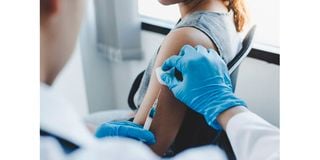Give HPV jab to youth to defeat cervical cancer

A few years ago, the HPV vaccine was introduced but, as usual, there are resistant movements and individuals who always have a negative ideology about anything and everything and, therefore, women and girls continue to be at risk.
Human papillomavirus (HPV) is the most common viral infection of the reproductive system.
Being a sexually transmitted infection (STI), the virus is carried by men and can be spread by having vaginal, anal or oral sex or close skin-to-skin touching during sex.
One can carry the HPV for a long time with no signs or symptoms and easily transmit it to their sexual partners.
According to the Centers for Disease Control and Prevention (CDC), in 2018, there were 43 million HPV infections and 13 million new ones.
Cervical cancer, one of the deadliest, is caused by insistent infection with high-risk types of HPV. The virus also causes other cancers—including cancer of the vulva, vagina, penis, anus and oropharyngeal cancer.
Although cervical cancer is deadly and often takes years to develop after a person gets HPV, it is one of the most preventable and treatable.
But reports show 604,000 women were diagnosed with cervical cancer in 2020 with 342,000 dying from the disease. The recent death of legendary journalist Catherine Kasavuli from cervical cancer should jolt the health authorities to action to save lives.
A few years ago, the HPV vaccine was introduced but, as usual, there are resistant movements and individuals who always have a negative ideology about anything and everything and, therefore, women and girls continue to be at risk.
Sexually active
We cannot afford to ignore the fact that adolescents and young people are not sexually active. Others are forced into sexual activities by close family members.
The vaccine is ideal for sexually active people in that they are at risk of being exposed to HPV. The ideal age for the vaccine taker is nine to 26 years.
Despite the many types of HPV, the vaccine can only prevent the most common strains—which cause cervical cancer, cancers of the vulva, vagina, anus, oropharynx and genital warts as well as the most common health problems caused by them.
Giving adolescents and young people the vaccine can prevent HPV transmission before one is exposed to it but does not treat existing infections or HPV-related diseases.
The Health Cabinet secretary ought to roll out the vaccine to primary and secondary schools to ensure that as many adolescents and young people as possible are inoculated.
Besides, the government should embrace the WHO global strategy to develop and implement comprehensive programmes with 90-70-90 targets for HPV vaccination, screening and treatment.
Although HPV can infect areas that are not covered by a condom, the use of condoms correctly and consistently, particularly for those who are sexually active, could lower the chances of getting HPV, hence reducing the risk of developing HPV-related diseases, including genital warts.
We live in a world where sex is readily available—as can be seen by the gonorrhoea strike—and abstinence might not be an option. But being in a faithful relationship and limiting the number of sexual partners can reduce the chances of getting HPV.
Ms Kathia is a sexual and reproductive health rights (SRHR) youth advocate and communications consultant. [email protected].





